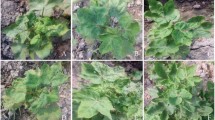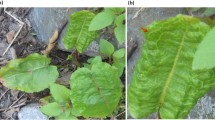Abstract
Codiaeum variegatum (common name, garden croton) is an ornamental plant grown for its bright yellow variegated leaf morphology. Two C. variegatum plants with upward leaf curling and vein swelling symptoms were collected in Faisalabad, Pakistan. Sequencing of clones obtained by PCR amplification with specific primers showed one plant infected with the monopartite begomoviruses pedilanthus leaf curl virus (PeLCV) and papaya leaf curl virus (PaLCuV) and the other to be infected with only PeLCV. Both plants also harboured a betasatellite that was distinct from all previously identified betasatellites, for which the name “codiaeum leaf curl betasatellite” (CoLCuB) is proposed. This is the first identification of a begomovirus and an associated betasatellite infecting C. variegatum in Pakistan. Both PeLCV and PaLCuV cause problems in a number of crop plants, and C. variegatum may act as a reservoir for these agriculturally important viruses. The precise impact and geographical distribution of the newly identified CoLCuB will be investigated.


Similar content being viewed by others
References
Akram A, Rasool G, Rehman A, Mansoor S, Briddon RW, Saeed M (2017) Identification of cotton leaf curl Kokhran virus and multiple satellite molecules infecting Jasminum sambac in Pakistan. J Plant Pathol 99(3):804
Akram A, Khan AH, Mansoor S, Moffett P, Briddon RW, Saeed M (2020) Detection and molecular characterization of clerodendron yellow mosaic virus infecting Volkameria inermis in Pakistan. J Plant Pathol. https://doi.org/10.1007/s42161-020-00529-y
Altschul SF, Gish W, Miller W, Myers EW, Lipman DJ (1990) Basic local alignment search tool. J Mol Biol 215:403–410
Briddon RW, Bull SE, Mansoor S, Amin I, Markham PG (2002) Universal primers for the PCR-mediated amplification of DNA b; a molecule associated with some monopartite begomoviruses. Mol Biotechnol 20:315–318
Briddon RW, Bull SE, Amin I, Idris AM, Mansoor S, Bedford ID, Dhawan P, Rishi N, Siwatch SS, Abdel-Salam AM, Brown JK, Zafar Y, Markham PG (2003) Diversity of DNA β: a satellite molecule associated with some monopartite begomoviruses. Virology 312:106–121
Brown JK, Zerbini FM, Navas-Castillo J, Moriones E, Ramos-Sobrinho R, Silva JF, Fiallo-Olivé E, Briddon RW, Hernández-Zepeda C, Idris A, Malathi VG, Martin DP, Rivera-Bustamante R, Ueda S, Varsani A (2015) Revision of Begomovirus taxonomy based on pairwise sequence comparisons. Arch Virol 160:1593–1619
Bull SE, Briddon RW, Markham PG (2003) Universal primers for the PCR-mediated amplification of DNA 1: a satellite-like molecule associated with begomovirus-DNA β complexes. Mol Biotechnol 23:83–86
Czosnek H, Hariton-Shalev A, Sobol I, Gorovits R, Ghanim M (2017) The incredible journey of begomoviruses in their whitefly vector. Viruses 9:2739
Doyle JJ, Doyle JL (1990) Isolation of plant DNA from fresh tissue. Focus 12:13–1510
Edgar RC (2004) MUSCLE: a multiple sequence alignment method with reduced time and space complexity. BMC Bioinformatics 5:113
Fondong VN (2013) Geminivirus protein structure and function. Mol Plant Pathol 14(6):635–649
Hamza M, Tahir MN, Mustafa R, Kamal H, Khan MZ, Mansoor S, Briddon RW, Amin I (2018) Identification of a dicot infecting mastrevirus along with alpha-and betasatellite associated with leaf curl disease of spinach (Spinacia oleracea) in Pakistan. Virus Res 256:174–182
Hassan I, Orílio AF, Fiallo-Olivé E, Briddon RW, Navas-Castillo J (2016) Infectivity, effects on helper viruses and whitefly transmission of the deltasatellites associated with sweepoviruses (genus Begomovirus, family Geminiviridae). Sci Rep 6:30204
Ilyas M, Qazi J, Mansoor S, Briddon RW (2010) Genetic diversity and phylogeography of begomoviruses infecting legumes in Pakistan. J Gen Virol 91:2091–2101
Ismail H, Hassan I, Zubair M, Khan MZ, Serfraz S, Jamil N, Mansoor S, Asad S, Amin I (2017) First report of Pedilanthus leaf curl virus, Tobacco leaf curl betasatellite, and Guar leaf curl alphasatellite infecting radish (Raphanus sativus) in Pakistan. Plant Dis 101:845
Jyothsna P, Haq QMI, Singh P, Sumiya KV, Praveen S, Rawat R, Briddon R, Malathi VG (2013) Infection of tomato leaf curl New Delhi virus (ToLCNDV), a bipartite begomovirus with betasatellites, results in enhanced level of helper virus components and antagonistic interaction between DNA B and betasatellites. Appl Microbiol Biotechnol 97:5457–5471
Kumar J, Kumar J, Singh SP, Tuli R (2014) Association of satellites with a mastrevirus in natural infection: complexity of Wheat dwarf India virus disease. J Virol 88:7093–7104
Kumar S, Stecher G, Tamura K (2016) MEGA7: molecular evolutionary genetics analysis version 7.0 for bigger datasets. Mol Biol Evol 33:1870–1874
Mahesh YS, Shankarappa KS, Rangaswamy KT, Prameela HA, Aswathanarayana DS, Divya BL, Nagesha N, Maruthi MN (2010) Detection and characterisation of a begomovirus associated with leaf curl disease of ornamental croton (Codiaeum variegatum). J Hortic Sci 85:101–105
Mansoor S, Briddon RW, Bull SE, Bedford ID, Bashir A, Hussain M, Saeed M, Zafar MY, Malik KA, Fauquet C, Markham PG (2003) Cotton leaf curl disease is associated with multiple monopartite begomoviruses supported by single DNA β. Arch Virol 148:1969–1986
Martin DP, Murrell B, Golden M, Khoosal A, Muhire B (2015) RDP4: detection and analysis of recombination patterns in virus genomes. Virus Evol 1:vev003
Muhire BM, Varsani A, Martin DP (2014) SDT: A virus classification tool based on pairwise sequence alignment and identity calculation. PLoS One 9:e108277
Munir S, Khurshid M, Kanwal H, Hussain M, Sattar MN, Ali I, Rehman A-u, Iqbal Z (2018) Identification of pedilanthus leaf curl virus and associated betasatellite infecting turnip in Pakistan. J Plant Pathol 100:317–321
Saritha RK, Shrawan S, Kalia P, Jain RK, Baranwal VK (2017) Association of Pedilanthus leaf curl virus and satellites with carrot (Daucus carota) in India. Plant Dis 101:843
Sattar MN, Kvarnheden A, Saeed M, Briddon RW (2013) Cotton leaf curl disease—an emerging threat to cotton production worldwide. J Gen Virol 94:695–710
Saxena S, Hallan V, Singh BP, Sane PV (1998) Nucleotide sequence and intergeminiviral homologies of the DNA-A of papaya leaf curl geminivirus from India. Biochem Mol Biol Int 45:101–113
Shahid MS, Mansoor S, Briddon RW (2007) Complete nucleotide sequences of cotton leaf curl Rajasthan virus and its associated DNA β molecule infecting tomato. Arch Virol 152:2131–2134
Singh-Pant P, Pant P, Mukherjee S, Mazumdar-Leighton S (2012) Spatial and temporal diversity of begomoviral complexes in papayas with leaf curl disease. Arch Virol 157:1217–1232
Srivastava A, Raj SK, Kumar S, Snehi SK (2013) New record of Papaya leaf curl virus and Ageratum leaf curl beta satellite associated with yellow vein disease of aster in India. New Dis Rep 28:5
Tahir M, Haider S, Iqbal J, Briddon RW (2009) Association of a distinct begomovirus and a betasatellite with leaf curl symptoms in Pedilanthus tithymaloides. J Phytopathol 157:188–193
Tahir MN, Mansoor S, Briddon RW, Amin I (2017) Begomovirus and associated satellite components infecting cluster bean (Cyamopsis tetragonoloba) in Pakistan. J Phytopathol 165:115–122
Yasmin S, Raja NI, Hameed S, Brown JK (2017) First association of Pedilanthus leaf curl virus, Papaya leaf curl virus, Cotton leaf curl Kokhran virus, and Papaya leaf curl betasatellite with symptomatic chilli pepper in Pakistan. Plant Dis 101:2155
Zerbini FM, Briddon RW, Idris A, Martin DP, Moriones E, Navas-Castillo J, Rivera-Bustamante R, Varsani A, Consortium IR (2017) ICTV virus taxonomy profile: Geminiviridae. J Gen Virol 98:131–133
Zhou X (2013) Advances in understanding begomovirus satellites. Annu Rev Phytopathol 51:357–381
Acknowledgements
The authors are grateful to Dr. Imran Amin, Dr. Brian E. Scheffler, and Ms. Fanny Liu for assistance with sequencing. This material is based upon work supported by the “Pak-US Cotton Productivity Enhancement Program” of the International Centre for Agricultural Research in the Dry Areas (ICARDA), funded by the United States Department of Agriculture (USDA), Agricultural Research Service (ARS), under agreement no. 58-6402-0-178F. Any opinions, findings, conclusions or recommendations expressed in this publication are those of the author(s) and do not necessarily reflect the views of the USDA or ICARDA. RWB was supported by the Higher Education Commission, Government of Pakistan, under the ‘Foreign Faculty Hiring Program’.
Author information
Authors and Affiliations
Corresponding author
Ethics declarations
Conflict of interest
The authors declare that they have no conflict of interest.
Ethical standards
The research reported here did not involve experimentation with human participants or animals.
Additional information
Handling Editor: Jesús Navas-Castillo.
Publisher's Note
Springer Nature remains neutral with regard to jurisdictional claims in published maps and institutional affiliations.
Electronic supplementary material
Below is the link to the electronic supplementary material.
Rights and permissions
About this article
Cite this article
Akram, A., Khan, A.H., Rasool, G. et al. Codiaeum variegatum in Pakistan harbours pedilanthus leaf curl virus and papaya leaf curl virus as well as a newly identified betasatellite. Arch Virol 165, 1877–1881 (2020). https://doi.org/10.1007/s00705-020-04633-3
Received:
Accepted:
Published:
Issue Date:
DOI: https://doi.org/10.1007/s00705-020-04633-3




